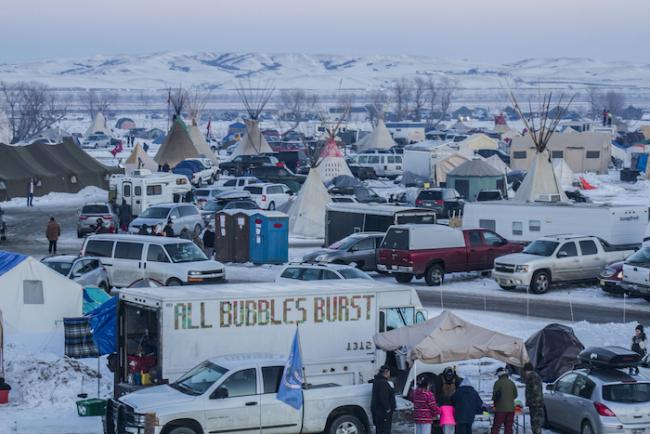
This piece appeared in the Fall 2021 issue of NACLA's quarterly print magazine, the NACLA Report. Subscribe in print today!
The Covid-19 pandemic marks a turning point in our collective history. The virus, in combination with longstanding social and economic cleavages, has produced a health crisis of epic proportions. The United States has seen some of the most severe outcomes in the world, in terms of the numbers of both cases and deaths. But the vulnerability to premature death, to echo Ruth Wilson Gilmore, has not been evenly distributed. Poor communities—particularly Black, Indigenous, Latinx, and immigrant communities—have experienced the heaviest losses.
The unevenness of this crisis, one of many we are currently facing, has forced a public reckoning with our racial-class structure and the forms of violence and privation it authorizes. Taken for granted assumptions about our putative democratic freedoms and rights are waning in the face of mounting evidence that suggests, quite forcibly, that the prevailing political and economic order—capitalism—is failing. It is failing poor people. It is failing historically constituted communities of color. It is failing the environment. Paradoxically, attempts to fix it are largely driven by proposals steeped in the same logics of accumulation that have rendered us differentially vulnerable in the first place and that reproduce a system that is ultimately anti-life.
In the midst of this painful wreckage, we have also witnessed a surge in social movement activism. The Movement for Black Lives, calls to abolish the police, and the ongoing struggle to dismantle the fossil fuel economy speak to spreading social discontent and the urgent need for change. On the morning of March 8, 2021, the global pandemic still raging, I met with Ruth Wilson Gilmore, abolitionist and professor of Earth and Environmental Sciences at the CUNY Graduate Center, and Nick Estes, citizen of the Lower Brule Sioux Tribe and assistant professor of American Studies at the University of New Mexico, to discuss how histories of colonial plunder, mass incarceration, and militarism intersect in the crucible of racial capitalism.
Gilmore and Estes begin with a critical assessment of U.S. energy policy and state-led resource extraction under Trump, which have continued, albeit under the guise of environmental stewardship, with the Biden-Harris administration. The purportedly “green” pretexts of the renewable energy transition that Biden touted in his presidential campaign, as Gilmore and Estes point out, does little to undo the pillage of our planet’s land, water, and mineral resources. Gilmore’s work on the “anti-state state” is crucial if we want to understand how and why attacks on the environment and social welfare, for instance, have unfolded alongside the expansion of prisons and other forms of incarceration, which speaks to another form of extraction: the extraction of time from incarcerated peoples. Time, she argues, is also a non-renewable resource. Collectively, they ask how we can harness the power of long-term movement building to transform “reformist reforms” into non-reformist reforms. This type of change is possible, but only if we can move beyond the seduction of hyper-identitarian political claims.
Gilmore and Estes’s respective areas of research—on abolition geographies and Indigenous resistance to colonial resource extraction—cut through the tendency within academia to silo conversations about race from a deeper understanding of our political economic system, which is global. The question is what work needs to be done to ensure a future in which Black and Indigenous peoples are not only present, but free of the ongoing forms of subjugation that plague our collective existence. This conversation has been edited for length and clarity.
Chris Loperena: Under the Trump administration, the U.S. government carried out blatant attacks on Black and Indigenous peoples through resource extraction—most recently oil leases in the Arctic National Wildlife Refuge in Alaska—and via the system of mass criminalization. These actions, which are of course rooted in a larger history of plunder, have given rise to unprecedented public conversations on the legacy and contemporary manifestations of white supremacy. How would you characterize the current state of affairs? What, if anything, is new about this moment?
Ruth Wilson Gilmore: Everything and nothing. During the Trump administration, we saw the acceleration of certain kinds of harm. The organization of organized violence was there for everybody to behold. Most clearly, I think, in the last year under Covid. But as we know, people in the United States and beyond have a habit of looking away. People look away from permanent war, look away from settler colonialism, look away from racism, look away from class war. Now the Biden-Harris administration is bombing Syria and caging children at the border and in detention centers strung down through Mexico and Central America. The Biden-Harris administration, despite having cancelled one pipeline, is going full-bore toward other pipelines and so forth. I don’t mean to say it doesn’t make any difference who holds the reins of power. I do mean to say there is a direction the world has been headed that hasn’t changed significantly with the recent change in Washington.
Nick Estes: I would add that the last year saw unprecedented mobilization in the streets. We saw the multiracial class unity that we often talk about on the Left organized against police brutality and police terror. Where we are now, from last summer to today, is something we should really interrogate. We went from this massive uprising, where there was a lot of spontaneity and organic movement building, but there was also long-term movement building that was in place. How did that become co-opted by the Biden campaign in his run for president? How did those demands get filtered into this very conservative, very right-wing candidate, even for the Democrats, and then get completely watered down, co-opted, and defanged?

What Ruthie pointed out with the cancellation of certain pipelines, cancellation of certain projects, or the “lip-service” to others is important. But it’s also important to remember that Biden himself was the vice president when Obama used the FBI to infiltrate the camps at Standing Rock. That wasn’t Trump. It was also Obama who refused to grant clemency to Leonard Peltier, one of the longest-serving political prisoners and an Indigenous activist who was protesting the very things the water protectors at Standing Rock were protesting.
Biden has also moved toward expanding what some people in the Democratic Party and Republicans call the new mineral frontier, or the renewable frontier. The renewable energy frontier extends what Obama did in his administration, which was to develop domestic energy production to wean the United States off “foreign oil” at the expense of Indigenous peoples and Indigenous lands. We see these lithium mines opening in places like Nevada. We see rare earth mining. Fundamentally, I would say we are moving away from a carbon economy. But a renewable economy requires the same forms of colonial resource extraction as the previous economy did.
RWG: The points you raised, Nick, are really crucial. One has to do with, as you so beautifully laid out, continuity of energy policy. Even when the thing being burned and consumed changes, the policy remains the same. The second thing related to that has two parts. One, the fact that the level of organization necessary for weaning the United States off certain kinds of energy sources does not reduce the United States’ desire or need—as the leading or second-leading capitalist economy on the planet—to control those resources, even if the United States is not going to consume them. That’s just kind of the story of oil. The second part has to do with what you were pointing toward, Nick, in talking about how enormous the uprisings were last summer and the fact that a lot of that appearance of spontaneity was shaped by already existing organizations and people in the United States and beyond. Certainly, the explosion of “support” for Black Lives Matter spread all over the planet, right? We’ve got a certain kind of internationalist consciousness at work that is extremely vulnerable to liberalism. So you raised really great questions for us to discuss.
CL: Nick, I want to talk about your book, Our History Is the Future. You begin with a dramatic scene from Black Friday 2016 when activists working to halt the Dakota Access Pipeline conducted a protest at a mall in Bismarck, North Dakota. The water protectors were quickly and violently repressed by the police. Can you explain the significance of this protest and the reaction to it? How are Indigenous peoples rendered threatening to the U.S. economy and hegemonic forms of consumption? Somehow, Indigenous bodies smelling like campfire smoke disrupted consumerism as normal.
NE: Yeah, the opening scene of smelling like campfire smoke is something I’ve experienced beyond the Standing Rock camps. Because ceremony is a really intrinsic part of Indigenous lifeways, one who smells like campfire in an urban space is obviously from the reservation and had obviously been participating in Indigenous things. It’s not just unique to the Standing Rock protests and uprisings. That scene itself, I think, builds on what Ruthie and I were discussing earlier. Even with oil and gas development in the fossil fuel economy, it’s undergirding levels of consumption. It’s the capitalist economy of accumulation that consumes. It doesn’t matter if you’re plugging so-called renewables or green energy into that system. It’s about maintaining the same levels of consumption as if that’s the only alternative.
If we look here in the Southwest where I’m from, you have a nation like the Navajo Nation. It’s larger than the state of West Virginia—it’s huge. It has uranium, oil, and gas, and now they're looking at the territory it has for solar, primarily. If we think not about an extractivist mindset that would say, “Oh, extraction is bad and therefore we should just do away with it,” but understand [extraction] within an imperialist kind of supply chain, then we understand colonialism for the Navajo Nation is about resource colonialism. The nation itself has tried to nationalize its resources over the last several decades going back to at least the 1970s—much the same way that leftist governments and some non-leftist governments have attempted to nationalize resources across the world. [Various such efforts have faced a backlash.] Whether it was Iran and the coup that happened in the 1950s or even recently with the coup in Bolivia. Venezuela is another good example.
The Navajo Nation is not the problem. They’re not overconsuming resources. One third of their population doesn’t have access to running water in their homes. Ten percent doesn’t have access to electricity in their homes. Why is it that their lands have to be sacrificed for fossil fuel extraction, whether that’s coal or now oil and gas, for the benefit of the southwestern economy and also the U.S. economy in general? Every attempt that the Navajo Nation has made to nationalize its resources has been met with resistance by the U.S. government at the behest of multinational corporations, but also by liberal environmentalists and NGOs. It’s not to say that they have bad intentions. There is alignment between certain Indigenous groups and some NGOs, but the extreme form of saying that all extraction is bad is a direct attack on tribal sovereignty.

The reason why I’m bringing all this up and how it relates to my book is because I’m trying to reframe our understanding of resource colonialism. To not just think about Indigenous peoples wanting to live in perfect utopia where we don’t need technology and we don’t need any forms of development and to actually disabuse ourselves of that notion because Indigenous peoples are not immune from extractivist economies. But also, when you put it in a framework of development and underdevelopment, we can understand that Indigenous peoples and nations were purposely underdeveloped for the taking of their resources. That’s what you have in a place like Standing Rock. What was the primary resource at play? Yes, it was oil and gas, but that oil and gas was coming from Fort Berthold Indian reservation. The other resource that was important was water. The protest erupted against the contamination of and the threat to the water.
This is not just some kind of weird particularism on behalf of Indigenous people or narrow nationalism to say we only care about the water for ourselves. It was to say, no, this is a common resource that should not be threatened. Not only is it threatening our livelihoods as Indigenous people, but it also threatens the livelihoods of people who live on this land with us. This is a phenomenon to show that Indigenous rights aren’t some particular local rite, but it can be universalized in a way. I think that’s what Standing Rock really represented. In my view and in my book, that opened up the possibility to go beyond these hyperidentarian or hyperlocal views of Indigeneity.
RWG: Nick you covered so many crucial issues and did what I always expect you to do, which is move through various scales and regions to show so explicitly what analysis is shaping the consciousness of people engaged in movements. The people we are talking about are so often, as you put it, represented in mainstream and social media as somehow simply expressing relation to land as a very local concern. Or simply expressing a “timeless” essence that adds up to being Indigenous. Your point relates so directly to the kinds of arguments that Walter Rodney made throughout his life. Certainly, How Europe Underdeveloped Africa is a book about resource colonialism—exactly. Whether the resource is extracted from the ground without a lot of intervention or something extracted by way of agriculture makes no difference to the sum effect of resource colonialism. The development of underdevelopment leaves us where we are today, which is “the global maldistribution of both symbolic and material resources” as Stuart Hall put it.
Read the rest of this conversation here, available open access for a limited time. View the full table of contents of the Fall 2021 issue of the NACLA Report here.
Nick Estes is a citizen of the Lower Brule Sioux Tribe. He is assistant professor of American Studies at the University of New Mexico, cofounder of The Red Nation, and host of The Red Nation Podcast. He is author of Our History Is the Future (2019).
Ruth Wilson Gilmore is professor of Earth and Environmental Sciences and American Studies at the CUNY Graduate Center. She is co-founder of many grassroots organizations and author of the prize-winning Golden Gulag (2007) and the forthcoming Change Everything (2022).
Christopher Loperena is assistant professor of Anthropology at the CUNY Graduate Center. He has served as an expert witness at the Inter-American Court of Human Rights and in support of asylum claimants. He is completing a book titled, A Fragmented Paradise: Blackness and the Limits of Progress in Honduras.

